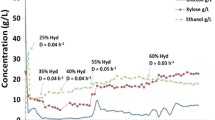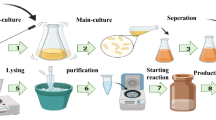Abstract
Two wild strains of Zymomonas mobilis were isolated (named as ML1 and ML2) from sugar cane molasses obtained from different farms of Santander, Colombia. Initially, selection of the best ethanol-producer strains was carried out using ethanol production parameters obtained with a commercial strain Z. mobilis DSM 3580. Three isolated strains were cultivated in a culture medium containing yeast extract, peptone, glucose and salts, at pH 6 and 32°C with stirring rate of 65 rpm during 62 h. The best results of ethanol production were obtained with the native strain ML1, reaching a maximum ethanol concentration of 79.78 g l−1. ML1 and ML2 strains were identified as Z. mobilis, according to the morphology, biochemical tests and molecular characterization by PCR of specific DNA sequences from Z. mobilis. Subsequently, the effect of different nitrogen sources on production of ethanol was evaluated. The best results were obtained using urea at a 0.73 g/l. In this case, maximum concentration of ethanol was 83.81 g l−1, with kinetic parameters of yield of ethanol on biomass (YP/X) = 69.01(g g−1), maximum volumetric productivity of ethanol (Qpmax) = 2.28 (g l−1 h−1), specific productivity of ethanol (qP) = 3.54 (h−1) and specific growth rate (μ) = 0.12 h−1. Finally, we studied the effect of different culture conditions (pH, temperature, stirring, C/N ratio) with a Placket-Burman′s experimental design. This optimization indicated that the most significant variables were temperature and stirring. In the best culture conditions a significant increase in all variables of response was achieved, reaching a maximum ethanol concentration of 93.55 g l−1.




Similar content being viewed by others
REFERENCES
Amutha R, Gunasekaran P (2001) Production of ethanol from liquefied Cassava Starch using co-inmobilized cells or Zymomonas mobilis and Saccharomyces diastaticus. J Biosci Bioeng 92:560–564
Bai FW, Anderson WA, Moo-Young M (2008) Ethanol fermentation technologies from sugar and starch feedstocks. Biotechnol Adv 26:89–105
Baptista CM, Cóias JM, Oliveira AC, Oliveira NM, Rocha JM, Dempsey MJ, Lannigan KC, Benson PS (2006) Natural immobilisation of microorganisms for continuous ethanol production. Enzyme Microb Technol 40:127–131
Brenner DJ, Krieg NR, Staley JT (2005) Bergey’s manual of systematic bacteriology. In: Garrity GM (ed) The proteobacteria (part A, B, C), vol 2, 2nd edn. Springer Edition, Michigan
Cazetta ML, Celligoi MAPC, Buzato JB, Scarmino IS (2007) Fermentation of malosses by Zymomonas mobilis: Effects of temperature and sugar concentration on ethanol production. Bioresour Technol 98:2824–2828
Choi G-B, Kang H-W, Kim Y-R, Cung B-W (2008) Ethanol Production by Zymomonas mobilis CHZ2501 from Industrial Starch Feedstocks. Biotechnol Bioprocess Eng 13:765–771
Coton M, Laplace JM, Coton E (2005) Zymomonas mobilis subspecies identification by amplified ribosomal DNA restriction analysis. Lett Appl Microbiol 40:152–157
Davis L, Roger P, Perace J, Peiris P (2006) Evaluation of Zymomonas-based ethanol production from a hydrolysed waste starch stream. Biomass Bioenerg 30:809–814
Dien B, Cotta M, Jeffries T (2003) Bacteria engineered for fuel ethanol production: current status. Appl Microbiol Biotechnol 63:258–266
Dworkin M, Falkow S, Rosenberg E, Schleifer K, Stackebrandt E (2006) The prokaryotes: a handbook on the biology of bacteria, vol 5, 3rd edn. Springer, New York
Fu N, Peiris P (2007) Co-fermentation of a mixture of glucose and xylose to ethanol by Zymomonas mobilis and Pachysolen tannophilus. World J Microbiol Biotechnol 24:1091–1097
Ghose TK, Tyagi RD (1979) Rapid ethanol fermentation of cellulose hydrolysate. I. Batch versus continuous system. Biotechnol Bioeng 21:1387–1400
Godoy E, Melim A, Oliveira C, Monteiro J, Pessoa A (2006) Effect of carbon:nitrogen ratio (C:N) and substrate source on glucose-6-phosphate dehydrogenase (G6PDH) production by recombinant Saccharomyces cerevisiae. J Food Eng 75:96–103
Kesava S, Rakshit S, Panda T (1995) Production of ethanol by Zymomonas mobilis: the effect of batch step-feeding of glucose and relevant growth factors. Process Biochem 30:41–47
Khongsay N, Laopaiboon L, Laopaiboon P (2010) Growth and btach ethanol fermentation of Saccharomyces cerevisiae on sweet sorghum stem juice under normal and very high gravity conditions. Biotechnology 9:9–16
Kida K, Morimura S, Kume K, Suruga K, Sonoda Y (1991) Repeated-batch ethanol fermentation by a flocculating yeast, Saccharomyces cerevisiae IR-2. J Ferment Bioeng 71:340–344
Li H, Chai X, Deng Y, Zhan H, Fu S (2009) Rapid determination of ethanol in fermentation liquor by full evaporation headspace gas chromatography. J Chromatogr 1216:169–172
Lin Y, Tanaka S (2006) Ethanol fermentation from biomass resources: current state and prospects. Microb Technol 627–642
Liu C, Dong H, Zhong J, Ryu D, Bao J (2010) Sorbitol production using recombinant Zymomonas mobilis strain. J Biotechnol 148:105–112
Malvessi E, Carra S, Silveira M, Ayub M (2010) Effect of substrate concentration. pH, and temperatura on the activity of the complex glucose-fructose oxidoreductase/glucono-δ-lactonase present in cacium alginate-inmobilized Zymomonas mobilis cells. Biochem Eng J 51:1–6
Miller G (1959) Use of dinitrosalicylic acid reagent for determination of reducing sugar. Anal Chem 31:426–428
Nellaia H, Karunakaran T, Gunasekaran P (1988) Ethanol Fermentation by an Efficient Strain, NRRL B-4286, of Zymomonas mobilis. J Ferment Technol 66:219–223
Philips RS (1996) Temperature modulation of the stereochemestry of the enzymatic catalysis: prospects for exploitation. Trends Biotechnol 14:13–16
Rakin M, Baras J, Vukasinovic M (2004) Beetroot juice fermentation. Food Technol Biotechnol 42:109–113
Ruanglek V, Maneewatthana D, Tripetchkul S (2006) Evaluation of Thai agro-industrial wastes for bio-ethanol production by Zymomonas mobilis. Process Biochem 41:1432–1437
Skotnicki M, Lee K, Tribe D, Rogers P (1981) Comparison of ethanol production by different Zymomonas strains. Appl Environ Microbiol 41:889–893
Srinivas MRS, Chand N, Losane BK (1994) Use of Plackett–Burman design for rapid screening of several nitrogen sources, growth/product promoters, minerals and enzymes inducer for the production of alpha-galactosidase by Aspergillus niger MRSS 234 in solid state fermentation system. Bioprocess Eng 10:139–144
Swings J, De Ley J (1977) The biology of Zymomonas. Bacteriol Rev 41:1–46
Tao F, Miao JY, Shi GY, Zhang KC (2005) Ethanol fermentation by an acid-tolerant Zymomonas mobilis under non-sterilized condition. Process Biochem 40:183–187
Wu K-J, Lo Y-C, Chen S-D, Chang J-S (2007) Fermentative production of biofuels with entrapped anaerobic sludge using sequential HRT shifting operation in continuous cultures. J Chin Inst Chem Eng 38:205–213
Yu X, Hallett S, Sheppard J, Watson A (1997) Application of the Plackett–Burman experimental design to evaluate nutritional requirements for the production of Colletotrichum coccodes spores. Appl Microbiol Biotechnol 47:301–305
Zhang M, Eddy C, Deanda K, Finkelstein M, Picataggio S (1995) Metabolic engineering a pentose metabolism pathway in ethanologenic Zymomonas mobilis. Science 267:240–243
Acknowledgments
We would like to thank Swarn Arya from Cornell University for helpful discussions and suggestions on this paper. The support of Laboratory of Chromatography-UIS is also gratefully recognized. This work was supported by VIE-UIS (Research Program).
Author information
Authors and Affiliations
Corresponding author
Electronic supplementary material
Below is the link to the electronic supplementary material.
Rights and permissions
About this article
Cite this article
Pinilla, L., Torres, R. & Ortiz, C. Bioethanol production in batch mode by a native strain of Zymomonas mobilis . World J Microbiol Biotechnol 27, 2521–2528 (2011). https://doi.org/10.1007/s11274-011-0721-7
Received:
Accepted:
Published:
Issue Date:
DOI: https://doi.org/10.1007/s11274-011-0721-7




